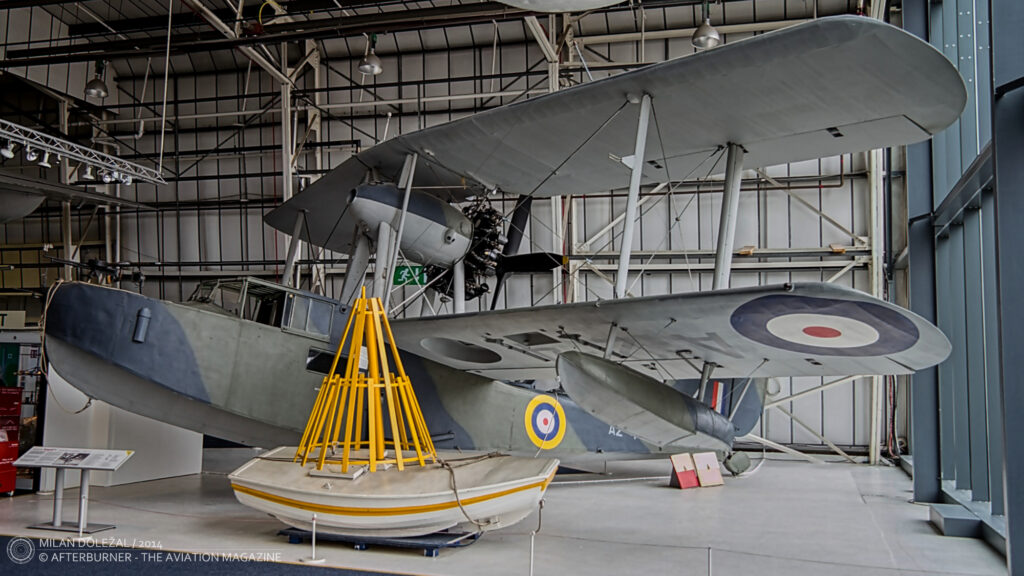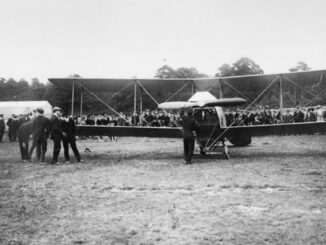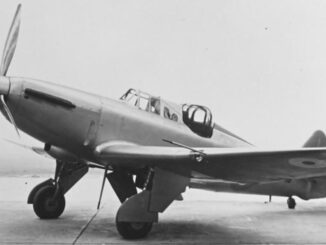 Supermarine Seagull V / Walrus (c/n A2-4, formerly ´A2-4´ of the Royal Australian Navy, then VH-ALB), exhibited at the Royal Air Force Museum in Hendon, London, July 2014.
Supermarine Seagull V / Walrus (c/n A2-4, formerly ´A2-4´ of the Royal Australian Navy, then VH-ALB), exhibited at the Royal Air Force Museum in Hendon, London, July 2014.
In May of 1921, the new flying boat developed by Supermarine performed its maiden flight. The aircraft was made as the company private venture and designed by its chief designer R.J. Mitchell.
One year later, the flying boat was approved by the Air Ministry for the Fleet Air Arm (FAA) service and designated Seagull. In 1925, the aircraft was also ordered by the Royal Australian Air Force (RAAF). The Royal Navy aeroplanes were mostly of the Mark II variant, while the Australian flying boats were known as Mark III. Finally, the Seagull was made in thirty-four examples and used by the FAA and the RAAF for artillery spotting and reconnaissance duties.
In 1929, the RAAF issued requirement for an observation seaplane which would be able to be catapult-launched from cruisers. It was responded by Mitchell, who undertook the task of adapting the Seagull for that specific requirement. And again, the development was carried out without any support from the authorities, as private venture of the Supermarine company, designated Type 236.
Although works on the new flying boat began already in 1930, the development was delayed by other Supermarine projects. Prototype of Seagull V, as the aircraft was designated, made its first flight only in June of 1933. A few days later, the flying boat was presented at Society of British Aircraft Constructors trade show in Hendon.
In its overall design, the Seagull V resembled the latest variant of its predecessor, the Seagull III. The flying boat was a biplane with all-metal hull made of anodised alloy and wings covered with fabric. It was powered by a single Pegasus II radial engine, generating 620 hp. The powerplant was in pusher configuration and being mounted in a nacelle located between the wings, braced with struts. The Seagull V was operated by a crew of four – two pilots, navigator and radio operator.
Even for the 1933, the design of Mitchell´s flying boat seemed to be very conservative and resembled the seaplanes from the final stage of the Great War. However, the Seagull V brought several technical innovations. It was the first British combat aircraft to be equipped with both hull made of metal, fully retractable undercarriage and enclosed cockpit for the entire crew.
In July of the same year, the prototype was handed over to naval authorities for evaluation. The Seagull V was tested aboard the Royal Navy battlecruisers and battleships, as well as some catapult trials were also performed. The Mitchell´s aeroplane was, with the highest probability, the first amphibian flying boat in the world to be launched with catapult.
Yet in 1933, the RAAF approved the flying boat and ordered twenty-four examples of the Seagull V. Two years later, an order for twelve examples was placed by the Royal Air Force. In the RAF service, the aircraft was designated Walrus, and that name was gradually adopted for the entire series.
A total of 740 examples of the Walrus flying boat was made, in three main variants – the initial Seagull V for the RAAF (27 examples), Walrus I (281 aircraft) and Walrus II (270 aircraft). The latter version was manufactured by Saunders-Roe and featured wooden hull, in order to reduce usage of the alloy during the war. Since 1937, the Walrus seaplanes were equipped with 750 hp Pegasus VI radial engine.
The Seagull V/Walrus flying boats served in their main role of gunnery spotter and observation aircraft until the late years of the World War II. However, their tasks were progressively taken over by radar and the seaplanes were transferred to search and rescue and liaison services.
Apart from the Commonwealth countries, the Walrus was also operated by Turkey which ordered six aircraft in 1938. After the war, a few examples of the flying boat were acquired by Argentina, Egypt and France. Most of them were retired from active service until the end of the 1950s.
The Seagull V preserved in the RAF Museum in Hendon is one of the flying boats from the initial RAAF order. The aircraft began its military service in February of 1936 and remained active with the RAAF until 1946.
At the end of that year, the Seagull was sold to private owner and registered VH-ALB. Then, the flying boat changed owners several times. In 1971, finally ended up in ´derelict and vandalised state´, as mentioned in the aircraft official history sheet of the RAF Museum.
In 1972, the Seagull V was acquired by the RAF Museum, moved to the UK and put under restoration. Seven years later, in November of 1979, the aircraft became part of the museum exhibition in Hendon, showcased with its original A2-4 Australian markings.



